|
The Cliff :
The geographical
zone of the better known cliff architecture extends from Kani Kombole
to Damasongo. The cliff stands more than
300 metres high. The upper part of the cliff is scattered with open
cave sites. Its base is a slope made of piled up boulders of rock. The
villages have been erected midway where the cliff's face and the slope
meet.
|
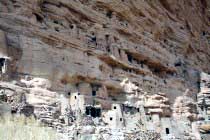 |
|
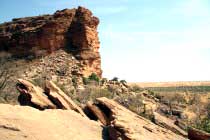 |
|
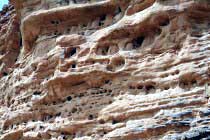 |
| ireli
|
|
the
cliff and the slope
|
|
the
cliff between ireli and pegue
|
|
Pegue Toulou
: The lower part of the village is built on the slope among the rocks
and the upper part gives the impression of being glued against the cliff's
wall. Dogon houses and Tellem constructions merge together. Many of
these ancient cave dwellings are still in use and serve as granaries
or collective burial places to the Dogon. There are two ways to reach
the village : either one follows meandering tracks going up the slope
from the plain below. Or one descends through narrow openings in the
face of the cliff.
|
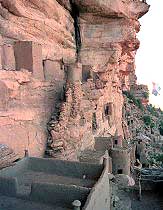 |
|
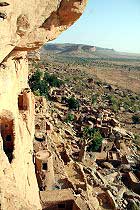 |
|
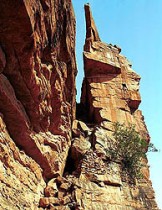 |
| pegue
toulou
|
|
pegue
toulou
|
|
pegue
toulou
|
|
The traditional
Dogon house is made of a central room which is flanked by a cylindrical
room (the kitchen), by two rectangular side rooms and by an entrance
hall. As usual, the terrace serves as a storing space for foodstuffs.
The traditional granary with its conical roof made of millet thatch
is a familiar site in many parts of Dogon country. In the cliff area,
slope declivity and the narrowness of surface available for construction
are such that the base of many granaries is to be supported by pillars
or stone walls.
|
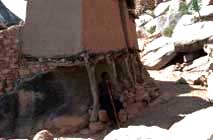 |
|
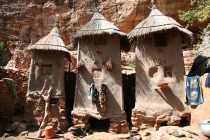 |
|
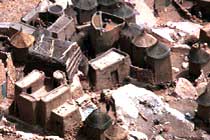 |
| pegue
toulou
|
|
kundu
kikinu
|
|
banani
serou
|
|
Yougo Dogorou
: The patronymic surname of Yougo Dogorou's
inhabitants is Doumbo which means "rock". The elderly say this
name refers to Bamba, a region where they stayed temporarily before
moving to and settling down on the isolated mountain of Yougo.
In "Les âmes des
Dogons ", G. Dieterlen does not mention any Doumbo migration via Bamba.
But in "Les Devises des Dogons - page 40", S. de Ganay states that the
Tige (see page 10) of Bamba is " bamba dumboo dumbo " meaning
" rock, the rock of Bamba ".
|
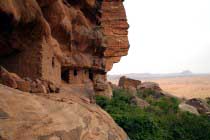 |
|
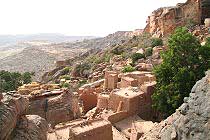 |
|
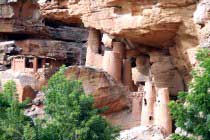 |
|
bamba mountain in background
|
|
yougo
dogorou
|
|
yougo
dogorou
|
|
Yougo Dogorou is
unique. It is perched next to the top of an isolated mountain separated
from the cliff. A gigantic rock, called "the anvil", rises next to the
village. Open caves sheltering Tellem and Dogon constructions overhang
the village. In ancient times the inaccessibility of the site protected
Yougo Dogorou against the outside world. Today its isolation has the
opposite effect. Most of the adult population moved to the villages
of the Seno-Gondo plains where working conditions are far easier. The
village is inhabitated by a few families and some elderly people who
are the guardians of the local altars. On certain occasions family members
and relatives will visit the village. On the death of an elderly parent,
they will gather in numbers and participate in funerary rituals and
dances.
|
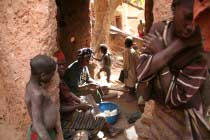 |
|
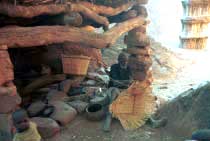 |
|
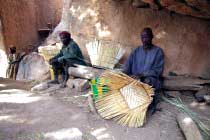 |
| yougo
dogorou
|
|
yougo
dogorou
|
|
yougo
dogorou
|
|
The face of the
cliff to the West of the village is strewn with open caves containing
constructions left by the Tellem. The first Dogon migrants from the
Arou tribe took up residence at the foot of this cliff. Traces of their
passage are still visible. Old foundations can still be discerned and
millstones lay around. There are no paths leading to this place. One
has to make a way around and over huge boulders.
|
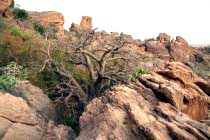 |
|
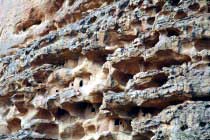 |
|
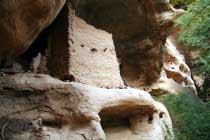 |
|
initial
place of settlement
|
|
initial
place of settlement
|
|
initial
place of settlement
|
|
As regards traditional
belief, two localities in Dogon country are of crucial importance. In
both cases the Arou tribe assumes supreme authority :
Arou is the place
of residence of the Hogon whose religious authority spans the whole
land. As a priest of agrarian rites, he represents the Earth, fertility
and life. He is to ensure the perpetuation of his people.
As regards Yougo
Dogorou, this is where commences the Sigui, the ritual that commemorates
the first ancestor who died in the form of a serpent (see page 42).
The ritual takes place once every 60 years and symbolizes the renewal
of generations.
It is also in this
village that the sacred cave of Albarga is located, the old man of the
myth who was discovered by Yayeme, the lady who confiscated the masks
from the Andoumboulou (see pages 37 & 40). People come from afar
to make sacrifices for protection against sorcery. Also, in case of
serious problems having to do with masks, the village elderly will be
consulted by visitors and matters will be discussed in the Togu Na bordering
the central village square.
Marcel Griaule
mentions in "Masques Dogons - page 765 " the existence at Yougo Dogorou
of Albarga's walking cane which is used in rites for rain making. Today
this rite is still of actuality. Villages in the region that suffer
from severe drought may call for this cane to intervene and block the
evildoers who are responsible for the lack of rain. Once every three
years, a delegation from Yougo Na, Yougo Dogorou and Yougo Piri will
visit those villages that asked for help. By means of the cane the culprit
will be ritually uncovered and he will die within the three years that
follow.
|
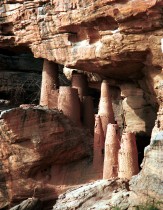 |
|
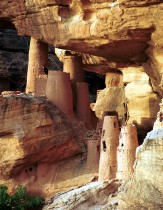 |
|
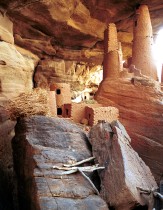 |
|
yougo
dogorou - 1986
|
|
yougo
dogorou - 1997
|
|
yougo
dogorou - 1997
|
|
With time passing,
people abandon Yougo Dogorou. Uninhabitated houses are unkept. After
a few rainy seasons they come crumbling down. The older constructions
built inside the open caves seem to stand the test of time. But even
then they do not always resist. Hereunder an example of the same spot
photographed a few years apart : among a group of centuries old towers,
two of them collapsed (photo in the middle).
|
| |
|
|
|
|
|
|